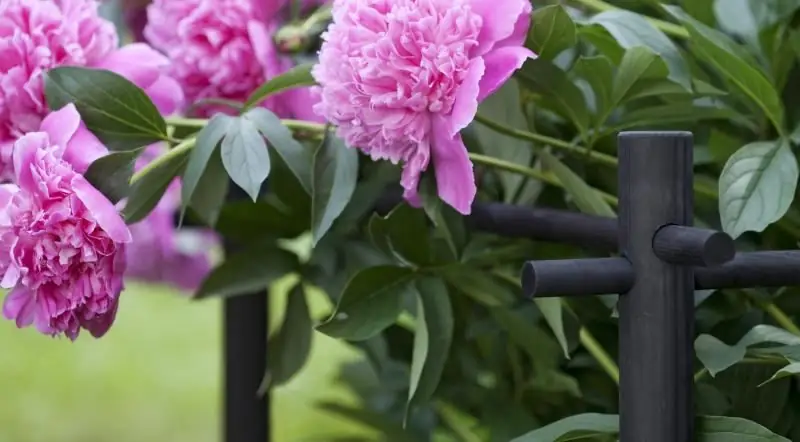
Table of contents:
- Author Bailey Albertson [email protected].
- Public 2024-01-17 22:26.
- Last modified 2025-06-01 07:32.
Strawberry Asia: an Italian guest in Russia

Large-fruited garden strawberries (also often called strawberries) Asia of Italian selection has been known in Russia for a little over ten years, but has already received recognition from gardeners. A bright, large, juicy berry with an excellent taste becomes your favorite from the first try. A description of the rules for caring for the variety will help gardeners, even beginners, grow a good harvest in their garden.
Content
-
1 Differences between strawberries and garden strawberries
1.1 Photo gallery: strawberries and garden strawberries
-
2 Description of the variety Asia
2.1 Table: characteristic of the variety
-
3 Planting strawberries
3.1 Step by step planting process
-
4 Care
- 4.1 Watering
- 4.2 Loosening
- 4.3 Mulching
-
4.4 Fertilizers and feeding
4.4.1 Table: ratio of timing and composition of fertilizing
- 4.5 Shelter for the winter
-
5 Breeding strawberries
-
5.1 Sockets
5.1.1 Video: cultivation of strawberries with outlets
-
5.2 Seeds
5.2.1 Video: seed propagation of strawberries
- 5.3 Dividing the bush
-
-
6 Diseases and pests
-
6.1 Table: Disease Control
6.1.1 Photo Gallery: Strawberry Diseases
-
6.2 Table: variety pests and control measures
6.2.1 Photo Gallery: Strawberry Insect Pests
- 6.3 Prevention of diseases and pests
-
- 7 Harvesting and storage
- 8 Reviews
Differences between strawberries and garden strawberries
Garden strawberries are often, by mistake or habit, called strawberries. But the crop that is now grown in our gardens is strawberries. She has large berries, short peduncles, fruits are easily separated from sepals. Strawberries were also cultivated until the beginning of the 20th century, but this berry is less susceptible to selection and large-fruited has not yet been bred.
Photo gallery: strawberries and garden strawberries
-

Strawberry - Strawberries, even when ripe, are not completely colored
-

Strawberries in the field -
Strawberry flower stalks are high, berries are small
-

Garden strawberry - Garden strawberries are much larger than strawberries
Description of the variety Asia
The bush is large, the leaves are large, bright green, shiny, slightly wrinkled. Peduncles are powerful, long. It forms a little mustache. The variety is adapted for mild climates.

Strawberries Asia have large bushes with large shiny leaves
The berries are elongated, bright scarlet, conical. Average weight - 30-35 g. In central Russia, it begins to bear fruit in mid-June, yield - about 1.5 kg per bush.
The surface of the fruit is shiny (as if varnished), with yellow seeds. The pulp is pink, very sweet, juicy, dense, without voids. It tolerates transportation well, does not wrinkle. Fruit tasting score - 4.5-5 points.

Asian berries - shiny, very sweet and juicy
The variety is suitable for industrial cultivation and for individual gardening. It grows and bears fruit well in the open field and in greenhouse conditions.
Table: variety characteristics
| Advantages | disadvantages |
| High yields. | Poorly tolerates winter without shelter. |
| Good taste. | Needs constant watering. |
| Resistance to diseases of the root system and various spots. | It is damaged by some diseases and pests (the variety is susceptible to chlorosis, especially on poor clay soils, anthracnose, powdery mildew). |
| Good transportability. | For good yields, top dressing or fertile soil is necessary. |
| Excellent presentation of berries. | |
| Over time, the fruits do not shrink. |
Planting strawberries
The best dates for planting are May and August. The first crop in both cases will ripen next summer.
The strawberries are grown in the sunniest spot in the garden. The site must be chosen flat so that water does not stagnate. Plantings should be replaced every 3-4 years, then the berries age and the yield decreases.

Every 3-4 years you need to change the place of the strawberry bed
Step-by-step planting process
- The site is carefully dug up, removing weeds, and at the same time 1 bucket of humus or compost is added per 1 m 2. You also need to add 5 kg of wood ash, 40 g of double superphosphate and 20 g of potassium sulfate.
- The distance between the plants in a row is 40 cm, between the rows is 60 cm, from the edge of the ridge when planting they retreat by 20 cm.
- Dig small holes, pour 0.5 buckets of water into them and carefully place the seedlings. It is better to transplant plants with a lump of earth, if the roots are open, you need to carefully straighten them and place them vertically.
- Before planting, granulated mineral fertilizers Harvest-super, Crystallin (1 tsp each) can be added to the hole and mixed with the ground.
- Gently fill in the hole, the root collar should be flush with the surface.
- Pour 0.5 buckets of water under each plant.
- When moisture is absorbed, cover the bed with hay, straw, compost, sawdust or other plant residues.

Leave 40 cm between bushes in a row

Strawberries Asia grows and bears fruit better under cover
Care
Watering, feeding, loosening contribute to the formation of a bountiful harvest of berries.
Watering
Asia is not coping well with drought. Without regular watering, the berries become smaller, become light, hollow. For the normal development and fruiting of strawberries, watering is required from the moment of planting until the end of August. The best option is drip irrigation, but you can do it in the usual way. How much water to pour under the bush and how often depends on the weather and soil structure on the site.

Drip irrigation is the best option for watering strawberries
Loosening
This technique can significantly increase the yield. After watering, you should wait until the water is absorbed and the earth dries slightly. Then shallowly (2 cm) loosen the planting. This will improve soil respiration, retain water in the ground.
Mulching
Mulch is good in that it maintains a normal level of moisture, and also, if it is of organic origin, rotting, fertilizes the soil. When loosening, it can be raked to the side, and then again distributed over the area.

Mulch prevents the soil from drying out
Fertilizers and feeding
Nitrogen, phosphorus and potassium are the three main chemical elements that strawberries especially need. There are important moments in plant life when these substances are especially important for a good harvest.
Table: the ratio of the timing and composition of fertilizing
| Feeding period | Mineral fertilizers |
A combination of mineral and organic fertilizers |
Organic fertilizers |
| April (bookmark of flower buds). |
|
Mullein solution 10 l, 1 tbsp. ash, 2 tbsp. l. superphosphate. |
A solution of chicken manure, mullein or herbal infusion. |
| Early May (budding period). | Potassium nitrate (2 tablespoons per 10 liters of water). |
Ash solution (1 tbsp per bucket of water). |
|
| August (laying the kidneys for next year). | Nitroammofoska root (1 tbsp. L. Per 10 l of water). |
Shelter for the winter
Asia can tolerate frost down to -15 o C. In the Russian continental climate, the plant needs shelter for the winter and protection from spring frosts. This is especially true for regions with little snowy winters.
At the end of summer, the land around the bushes needs to be loosened and mulched. Spruce branches and pine needles are used as a covering material. Hay and straw are also popular, but mice love to live under them. In spring, mulch is harvested early so that the bushes under the “roof” do not begin to grow.
Strawberry propagation
The culture is propagated by dividing the bush, seeds and rooting outlets.
Outlets
The best way to grow a strawberry plantation is by rooting outlets.

The easiest way to propagate strawberries is by rooting outlets.
At the end of fruiting, the bushes grow a large number of mustaches. These are creeping shoots that can reach a length of 1 m or more. On each of them, rosettes of leaves and small roots are formed. They are pinned to the ground using special wire pins, periodically watered. When the rosettes take root, they are transferred to a new bed.
Video: cultivation of strawberries with sockets
Seeds
The next way to propagate strawberries is to get seeds and germinate them.
- To do this, ripe berries are cut in such a way that the seeds remain on a thin cut.
- These sections are dried, the seeds are hulled and stored.
- Sow them in February next year.
- It is best to plant seeds in clear plastic containers.
- When the sprouts form a third leaf, they are carefully dived into separate cups, and transplanted into the ground in the spring.

Seeds planted in January can produce flowering bushes in June
Video: propagation of strawberries by seeds
By dividing the bush
This method is resorted to if you need to transfer the plant to a new place or there is very little seed.
The bush is dug out and carefully divided in such a way that each part has an intact heart (horn) and young white roots. The divided parts of the bush are planted in the usual way.

The bush is divided into 2-3 parts
Diseases and pests
This variety is highly resistant to many diseases, but prone to chlorosis, anthracnose, powdery mildew.
Table: Disease Control
| Diseases | Description | Treatment |
| Chlorosis | When grown in poor and calcareous soils, Asia strawberries can be damaged by chlorosis. This comes from the inability to absorb iron and magnesium. The leaves turn yellow and dry out. |
|
| Anthracnose | The disease is caused by a fungus. Purple spots appear on the leaves and stems, then they turn gray and are bordered by a purple stripe. Leaves dry and fall off. |
|
| Powdery mildew | The leaves curl inward, turn purple, and become covered with a white coating. The berries are ugly, small, with a mushroom smell. | Before flowering and after harvesting, Topaz, Fundazol, Acrobat MC, Skor, Previkur, Amnistar extra are used. It should be sprayed abundantly so that it drips from the bushes. The soil under the plants should also be treated. Repeat the procedure if necessary. |
Photo gallery: strawberry diseases
-

Chlorosis of strawberries - Strawberry chlorosis develops on poor soils
-

Strawberry anthracnose - Anthracnose can destroy the entire crop
-

Strawberry powdery mildew - Powdery mildew weakens strawberries
Table: pests of the variety and control measures
| Pests | Description | Control measures |
| Strawberry raspberry weevil | Gray beetles 3 mm long. They hibernate in fallen leaves, under clods of earth. In the spring they lay eggs in buds, eat them out from the inside. In June or July, young beetles gnaw on foliage. They leave for wintering in the fall. |
|
| Strawberry mite | Hibernates in leaf stalks. In spring, it lays eggs on young leaves. The leaf blades wrinkle, gradually die off. |
|
| Strawberry leaf beetle | The beetle is 4 mm long. In spring, pests are selected from plant residues, in which they winter, and begin to eat strawberry leaves. During the flowering period, insects lay eggs, and after two weeks the larvae begin to feed on foliage. |
|
Photo gallery: strawberry insect pests
-

Strawberry raspberry weevil - Strawberry-raspberry weevil eats buds and leaves
-

Strawberry mite - Strawberry mite feeds on plant juices, can destroy the entire planting
-

Strawberry leaf beetle - Strawberry leaf beetle leaves holes through
Prevention of diseases and pests
The garden is best protected by simple measures that deprive pathogens and pests of a suitable habitat.
- Thorough cleaning in spring and autumn of plant residues and their destruction.
- Loosening the soil and digging row spacings.
- Soil and planting treatment in autumn and spring before flowering with Karbofos, Fitosporin, copper-containing preparations.
- Permanent weed removal.
- Planting in aisles of garlic, calendula, marigolds, nasturtium, dill, parsley, coriander.
- Application of organic fertilizers to depleted and calcareous soils, 3 buckets per 1 m 2 in spring and autumn.
- Application for healing and stimulation of plants of preparations Immunocytophyte, Zircon.
Harvesting and storage
Strawberries should be picked in dry weather. It is advisable to immediately release the berries from the stalks. The fruits are used, first of all, fresh. Strawberries make great desserts, baking fillings, creams, soufflés. For preservation for the winter, jam, jelly, juices, mashed potatoes with sugar, and homemade wine are prepared from berries.

Fresh berries are a tasty and healthy treat
To keep fresh strawberries in the refrigerator for 7-10 days, they are sorted and carefully transferred into low and wide food containers. First, you need to chill the berries without a lid to eliminate the formation of moisture.
Reviews
Strawberry Asia is a gentle southern variety. But it bears fruit well in Russia and has received many positive reviews. But it is worth remembering that a native of Italy does not tolerate winter cold very well.
Recommended:
Garden Lilies - Planting And Care, Photo And Video (oriental, White, Tubular)

Features of the species and varieties of garden lilies. Tips for planting lily bulbs. advice on growing and care
Garden Strawberry Variety Tsaritsa - Features, Care And Other Important Aspects + Photo

Description of the garden strawberry variety Tsaritsa. Advantages and disadvantages. Planting, care and reproduction. Disease and pest control. Harvesting. Gardeners reviews
Chamora Turusi Variety Of Garden Strawberries - Features, Care And Other Important Aspects, The Difference Between Strawberries And Garden Strawberries + Photo

Everything about the Chamora Turusi strawberry variety: from planting and care to picking berries. Productivity, terms of fruiting, reviews of gardeners
How To Build A Decorative Fence For A Garden And Other Needs With Your Own Hands - Step By Step Instructions With A Photo

You can make an original and unique decorative fence from the simplest materials, besides, do it yourself. Step-by-step instructions, photo
Fences For Garden Beds With Your Own Hands - How To Make A Fence For A Front Garden, Flower Garden Or Vegetable Garden, Step By Step Instructions With A Photo

Options for fences for a suburban area. Their pros and cons. How to install a holder for plastic bushes, a flower bed from bottles: step by step instructions. Video
